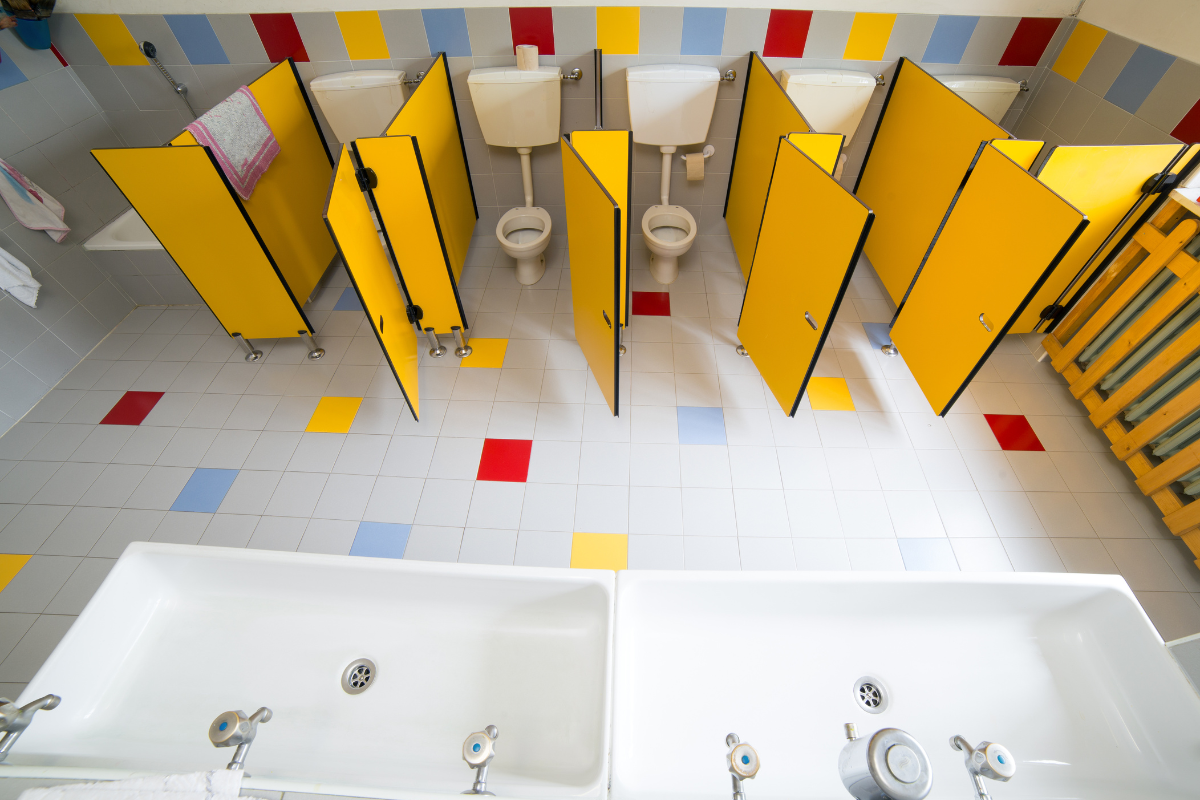 FREE UK DELIVERY.
EXPRESS OPTIONS AVAILABLE
FREE UK DELIVERY.
EXPRESS OPTIONS AVAILABLE

School Toilet Regulations UK: Understanding Compliance Standards
|
|
Time to read 7 min
 FREE UK DELIVERY.
EXPRESS OPTIONS AVAILABLE
FREE UK DELIVERY.
EXPRESS OPTIONS AVAILABLE
 UP TO 10 YEARS GUARANTEE
FOR PEACE OF MIND
UP TO 10 YEARS GUARANTEE
FOR PEACE OF MIND
 30 DAY RETURNS
NO QUIBBLE GUARANTEE
30 DAY RETURNS
NO QUIBBLE GUARANTEE
|
|
Time to read 7 min
Let’s face it—school toilets might not be the most glamorous topic, but they play a critical role in keeping students healthy, safe, and comfortable throughout the school day.
Navigating the rules around school washroom and toilet facilities in the UK can feel overwhelming, but understanding these regulations is crucial for ensuring every student has access to clean, safe, and accessible facilities.
In this guide, we’ll break down the essential regulations that schools need to follow. Whether you're managing an academy, a primary school, or a pupil referral unit, knowing these rules will help you create washrooms that are safe, welcoming, and compliant with the law.
Schools must adhere to specific toilet regulations for health, safety, and accessibility.
Different school types have unique requirements based on statutory guidelines.
Maintaining hygiene and regular upkeep of washroom facilities is critical for student wellbeing.
School toilet regulations are not just about ticking boxes—they are essential to providing a safe, welcoming, and hygienic environment for students and staff.
School washrooms must be accessible, easy to maintain, and designed to cater to different age groups, as well as the needs of those with disabilities.
Complying with these regulations helps schools create a positive learning environment that supports the health and wellbeing of all students and staff.
While local authorities oversee the implementation of these regulations, school leaders are responsible for the daily management and upkeep of toilet facilities.
Regular checks and maintenance of both student and staff toilets are essential to keep everything in good working order, ensuring that the facilities meet both health and safety standards.
School leaders must take proactive steps to inspect, update, and maintain their toilet facilities. This ensures compliance with current regulations and safeguards the wellbeing of students and staff.
In the UK, school toilet facilities are subject to several important regulations. These regulations also specify the design and number of toilet cubicles required to ensure safety and accessibility.
These regulations include the Education Act 1996, School Premises Regulations 2012, and various Building Regulations. They ensure schools provide safe, hygienic, and accessible environments for students.
Education Act 1996: This legislation ensures that schools offer adequate toilet facilities to support the health, safety, and welfare of students.
School Premises Regulations 2012: These standards outline the minimum requirements for sanitary facilities based on school size and pupil numbers, including gender-specific provisions and considerations for students with special needs.
Guidance on Facilities: Schools must ensure that toilet and washroom facilities are located at appropriate distances from classrooms, as per the Department for Education’s standards, to reduce disruption to learning and ensure easy access for all students, including those with disabilities.
By adhering to these regulations, schools can ensure they meet their legal obligations while providing an environment where students feel comfortable and secure.
In the UK, school washroom facilities and toilet regulations vary depending on the type of school. Each type has specific provisions that must be met to ensure the health and safety of students.
Academies and Free Schools: Must provide separate facilities for boys and girls over age eight, with hot and cold water, soap, and drying options. Facilities must comply with the School Premises (England) Regulations 2012 for ventilation, natural light, and regular maintenance.
Independent and Special Schools: Require sufficient toilets and accessibility for students with disabilities. Special schools may need features like hoists or changing benches, following the Education (Independent School Standards) Regulations.
Pupil Referral Units (PRUs): Must have secure, private facilities with emergency access, following regular hygiene and safety inspections, as outlined by building regulations.
UK school washroom and toilet regulations focus on hygiene and accessibility, covering sinks, toilets, and disabled access. Here are some general guidelines, although these may vary based on the type or location of the school.
Sinks and Wash Troughs: Sinks should be height-appropriate, especially in primary schools, and wash troughs are efficient for multiple users. Schools should provide one sink per toilet if fewer than three, or two sinks for every three toilets/urinals. Soap and drying facilities must be readily available.
Toilet and Urinal Count: Schools must provide one toilet per 20 pupils, with urinals making up two-thirds of male fixtures. Balanced distribution ensures regulations are met, avoiding long waits.
Disabled Toilets and Universal Access: Accessible toilets should include space for wheelchair manoeuvring, grab rails, and low-level basins. Universal facilities must cater to diverse needs with fixtures like hooks and dispensers at various heights, ensuring privacy and compliance with accessibility standards.
Designing and maintaining school toilets involves key aspects including proper accommodation, appropriate lighting and privacy, availability of hot water, and provisions for pupils with specific needs.
In recent years, unisex toilets have become increasingly popular in schools, offering benefits such as reduced bullying and improved hygiene. Ensuring these areas are adequately addressed promotes hygiene and wellbeing for all students.
Schools must provide the appropriate number of toilets, typically one per 20 students over the age of 5. Cubicles should be spacious, private, and durable, with secure locks. For students over eight, separate toilets for boys and girls are required unless unisex toilets are used, which should offer full privacy. Regular maintenance checks are essential to keep the toilet facility in top condition.
Effective lighting in school toilets is not only important for safety but also contributes to a welcoming environment.
Cubicles must be designed to ensure privacy, with no gaps or awkward spaces that compromise students' dignity. Safety features, such as easily accessible emergency buttons, are also a must.
Routine checks should be carried out to ensure that lighting, safety mechanisms, and privacy features remain functional and up to standard.
Hand hygiene is critical in preventing the spread of illness, making access to hot water in school toilets a must. Schools should install thermostatic valves on taps and thermostatic shower valves in showering facilities to maintain a safe water temperature and prevent scalding. Proper hand washing facilities, including soap dispensers and hand dryers or paper towels, should be regularly replenished and well-maintained.
Schools must provide accessible toilet facilities for disabled pupils, including those who experience incontinence. These should include accessible toilets with additional space for assistance, along with appropriate features such as handrails, hoists, and changing benches where necessary.
Ensuring these facilities are kept clean and well-stocked with disposable hygiene products helps maintain dignity and comfort for all students. Training staff on how to manage these situations sensitively is also essential.
One essential feature in school washrooms that often goes unnoticed but plays a crucial role in student safety is the thermostatic mixing valve (TMV). These valves are designed to control the water temperature at handwashing stations and showers, preventing the risk of scalding while ensuring that hot water is available for proper hygiene.
A thermostatic mixing valve blends hot and cold water to a pre-set, safe temperature before it reaches the tap. This is especially important in school environments where younger children might not be able to regulate water temperature effectively. The TMV ensures that water is delivered at a consistent, safe temperature, reducing the risk of burns.
Thermostatic valves are critical in maintaining safety standards in school washrooms for several reasons:
Safety: The primary function of TMVs is to prevent scalding, which can occur if water from the tap or shower is too hot. By regulating the temperature, TMVs ensure that students, especially younger ones, are protected from potential harm.
Compliance: Many hygiene standards and building regulations require schools to install TMVs in their facilities. Compliance with these guidelines not only safeguards students but also ensures that schools meet their legal obligations.
Energy Efficiency: TMVs help maintain energy efficiency by ensuring hot water systems run optimally, reducing the need for constant manual adjustments of water temperatures in school washrooms. This helps schools manage their energy costs while maintaining student safety.
Maintaining safe and hygienic school toilets is crucial for supporting student wellbeing and ensuring a positive learning environment. By following the necessary regulations and keeping facilities clean, accessible, and well-maintained, schools can create a space where students feel comfortable and secure.
At House of ENKI, we provide a wide range of high-quality bathroom fixtures designed to enhance the functionality and style of your school washrooms. Whether you’re upgrading your current facilities or designing new ones, our durable taps, sinks, and more can help you create the ideal space.
Ready to improve your school's restrooms? Browse our range of products for commercial bathrooms or contact us to find the perfect solutions for your needs.





